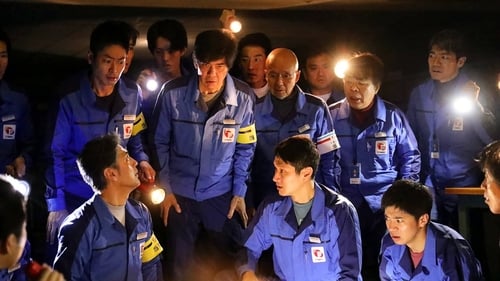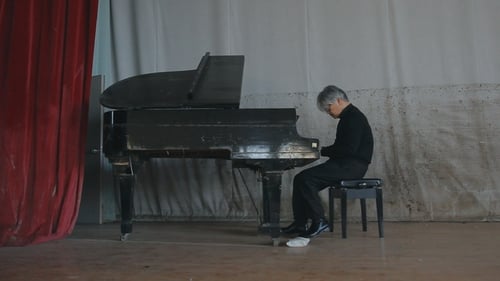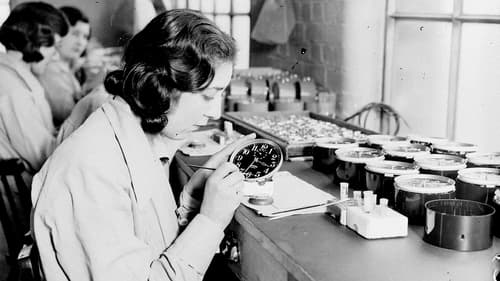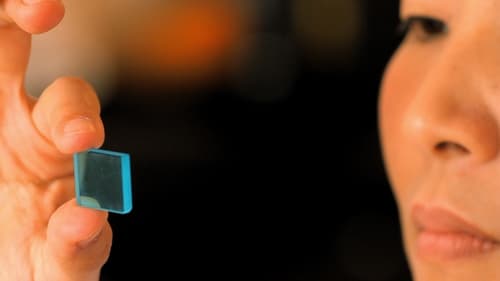Savagely, silence (2017)
장르 : 다큐멘터리
상영시간 : 20분
연출 : Vincent Guilbert
시놉시스
December 21, 2015. The image of a fox was captured by a camera inside the unit 2 building at Fukushima No.1 nuclear power plant... A film-essay about contemporary Japan in the aftermath of March 2011 earthquake.

2011년 3월 11일 오후 2시 46분, 동일본 대지진이 발생한다. 후쿠시마 원자력 발전소 제1발전소는 위험한 상황에 빠진다. 원전 안에 남아, 사고를 수습한 후쿠시마 출신의 작업원들은 해외 언론 매체들에 의해 '후쿠시마의 50인(Fukushima 50)'이라고 불렸다. 그 안에서 과연 무슨 일이 일어나고 있었던 것일까? 진실은 무엇일까? 동일본 궤멸이라는 위기가 다가오는 와중에도 고뇌에 찬 결단을 내려야 했던 그들은 과연 무슨 생각을 하고 있었을까?

세계적으로 주목 받은 아티스트이자, <마지막 황제>(1987) 오리지널 사운드트랙 작업으로 아카데미, 골든글로브, 그래미를 석권한 작곡가 류이치 사카모토는 인후암 판정 이후 모든 활동을 중단한다. 하지만 평소 존경하던 이냐리투 감독으로부터 작업의 의뢰를 받게 되면서 다시 작업을 시작하게 된 류이치 사카모토는 치료로 중단했던 새 앨범을 다시금 준비하기 시작한다.

젊은 독일 여성 마리는 자신의 삶을 변화시키기 위해 후쿠시 마로 도망치듯 떠나온다. 클라운즈 포 헬프(Clowns4Help) 라는 단체와 함께 일하며 2011년 후쿠시마 원전사고의 생존 자들에게 기쁨을 전해줄 수 있길 바란 것이다. 마리는 오래 지나지 않아, 자신이 그 비극에서 고달픔을 덜어내는 임무에 전혀 적합하지 않다는 것을 깨닫게 된다. 하지만 마리는 거 기서 도망치기보다 성미가 고약한 사토미라는 이름의 노인 과 함께 지내기로 결정한다.
(2016년 제18회 서울국제여성영화제)

A powerful documentary that sheds some light on what really happened at the Fukushima nuclear power plant after the 2011 earthquake and the tsunami that immediately followed. A powerful documentary - shot from March 11th, 2011 through March 2015 - that sheds some light on what really happened at the Fukushima nuclear power plant after the 2011 earthquake and the tsunami that followed.

The exciting story of the splitting of the atom, a scientific breakthrough of incalculable importance that ushered in the nuclear age, has a dark side: the many events in which people were exposed to radiation, both intentionally and by accident.

December 21, 2015. The image of a fox was captured by a camera inside the unit 2 building at Fukushima No.1 nuclear power plant... A film-essay about contemporary Japan in the aftermath of March 2011 earthquake.

2011년 3월 11일. 동일본 대지진이 일어난 후 정치부 기자인 나베시마는 지진과 정부의 대처를 취재하던 중, 무언가 심상찮은 일이 일어나고 있음을 눈치챈다. 어렵사리 얻어낸 정보는, 지진으로 후쿠시마 원전 냉각장치가 멈추었다는 것! 그러나 정보는 제한되어 있고 정부의 대처는 답답하기만 하다. 직접 도비(東日)전력 원자력부에 몸담았던 요코하마씨를 찾아내 취재하는 나베시마. 그러나 그가 말해주는 진실들은 더욱 놀라운데…

Six months after the explosions at the Fukushima nuclear plant and the release of radiation there, Professor Jim Al-Khalili sets out to discover whether nuclear power is safe. He begins in Japan, where he meets some of the tens of thousands of people who have been evacuated from the exclusion zone. He travels to an abandoned village just outside the zone to witness a nuclear clean-up operation. Jim draws on the latest scientific findings from Japan and from the previous explosion at Chernobyl to understand how dangerous the release of radiation is likely to be and what that means for our trust in nuclear power.

Chernobyl 1986. A nuclear reactor exploded, spewing out massive quantities of radiation into the atmosphere. Within days, the pollution had spread across Europe. Living on land contaminated with radioactivity would be a life-changing ordeal for the people of Belarus, but also for the Sami reindeer herders of central Norway. It even affected the Gaels of the distant Hebrides. Five years ago there was a meltdown at the Fukushima reactor, and thousands of Japanese people found their homes, fields and farms irradiated, just as had happened in Europe. This international documentary, filmed in Belarus, Japan, the lands of Norway's Sami reindeer herders and in the Outer Hebrides, poses the question: what lessons have we learned?


Fukushima's Minami-soma has a ten-centuries-long tradition of holding the Soma Nomaoi ("chasing wild horses") festival to celebrate the horse's great contribution to human society. Following the meltdown of the Fukushima Daiichi Nuclear Power Plant in the wake of the March 11, 2011 earthquake and tsunami, local people were forced to flee the area. Rancher Shinichiro Tanaka returned to find his horses dead or starving, and refused to obey the government's orders to kill them. While many racehorses are slaughtered for horsemeat, his horses had been subjected to radiation and were inedible. Yoju Matsubayashi, whose "Fukushima: Memories of the Lost Landscape" is one of the most impressive documentaries made immediately after the disaster, spent the summer of 2011 helping Tanaka take care of his horses. In documenting their rehabilitation, he has produced a profound meditation on these animals who live as testaments to the tragic bargain human society made with nuclear power.

The Japanese population’s reaction to the catastrophe of March 2011 has been described as “stoic” by the Western media. The Japanese code of conduct is indeed deeply rooted in their Buddhist traditions, and young filmmakers Tim Graf and Jakob Montrasio observe in detail what this means for the people and their religion. At graveyards, in temples, at monasteries and with families, they question the impact this triple affliction has had on the lives and beliefs of the inhabitants. How deeply do their beliefs affect their grieving? What role do the monks play in assisting people with their grief? And, what effects has this enormous catastrophe had on their religious rituals? SOULS OF ZEN inserts the events of March 2011 into the context of traditional Zen Buddhism, examining Japan’s religiousness and the beliefs of those practising it at a crucial turning point.

After the 11 March 2011 tsunami and nuclear disaster, residents of Futaba, a town in Fukushima Prefecture, are relocated to an abandoned high school in a suburb of Tokyo, 150 miles south. With a clear and compassionate eye, filmmaker Atsushi Funahashi follows the displaced people as they struggle to adapt to their new environment. Among the vivid personalities who emerge are the town mayor, a Moses without a Promised Land; and a farmer who would rather defy the government than abandon his cows to certain starvation.

Tokyo = Fukushima is a time-lapse, stop-frame animation film of the city of Tokyo, six months after the nuclear meltdown at Fukushima. The film depicts Tokyo as throbbing with life and (nuclear) electricity despite the crisis and constant radioactive threat. Recorded over a two-month period, using a Bolex Super 16mm wind-up camera on the streets of Tokyo, the film acts as a love letter to an anxious friend. The city is trying to return to normal, although paranoia and anxiety are found everywhere due to minor earthquakes, aftershocks and government untruths. This beautiful and dark film is propelled by electronic music recorded by the filmmaker in Tokyo.

True story of an American volunteer who discovered the unvarnished truth about the Fukushima nuclear disaster cover-up while living in Japan. A critical look at how the authorities handled the nuclear crisis and Tsunami relief by an American who volunteered in the clean-up.

Over a year since three nuclear reactors went into full meltdown at the Fukushima Daiichi Nuclear Power Plant, a broad anti-nuclear movement is growing in Japan. Nowhere is that more apparent that in Fukushima Prefecture, where a group of local women protest the deafening silence of the Japanese government. Ignored by their own media, these women share their brutally honest views on the state of the clean up, cover-ups, untruths and the stagnant political climate in modern Japan.


The Radiant explores the aftermath of March 11, 2011, when the Tohoku earthquake triggered a tsunami that killed many thousands and caused the partial meltdown of the Fukushima Daiichi nuclear power plant on the east coast of Japan. Burdened by the difficult task of representing the invisible aftermath of nuclear fallout, The Radiant travels through time and space to invoke the historical promises of nuclear energy and the threats of radiation that converge in Japan in the months immediately following the disaster.

매스컴의 발표를 믿지 못해서 동네 구석구석을 다니며 방사능 오염을 측정하는 주부 시바타 씨. 더 이상 일본엔 안전한 곳이 없다며 손주의 장래를 걱정 할 때마다 울먹이는 구로타 할머니… 원전 사고의 후유증은 여전히 현재 진행 중이며 그 끝을 예측조차 할 수 없다는 사실에 일본인들의 불안과 공포는 하루하루 증폭되어 가고 있다. 아무도 이야기 해주지 않는 후쿠시마의 두려운 미래를 찾아 17인의 평범한 시민들이 죽음의 땅으로 위험한 여정에 나섰다. 우크라이나 정부의 허가를 받고 어렵게 들어간 체르노빌 현장은 충격적이었다. 인구 5만이 살던 첨단 도시는 폐허로 변했고, 일부에선 놀랍게도 허용치의 300배가 넘는 방사선량이 검출된다는 사실에 모두들 경악했다. 강제 이주민들은 여전히 죽음의 공포와 실향의 서러움에서 벗어나지 못하고 있으며, 나이 어린 피폭 2세들은 병명조차 알 수 없는 각종 질환에 시달리고 있다. 28년이 흘렀지만 아직도 끝나지 않은 체르노빌 사고의 심각한 후유증... 후쿠시마는 어디로 가는 것일까? 과연 일본은 비상구를 찾을 수 있을까?

'No-go zone' chronicles the daily life of the last man remained in the red zone after the evacuation of the Fukushima area and the nuclear power plant accident.








